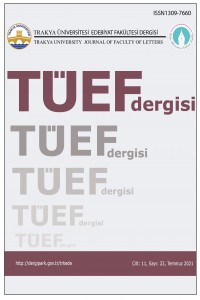Abstract
Translated literature and the research to be carried in this field give us useful data related the concerned languages and cultures. For this reason, it is thought that to analyse the translation of a literary work of art would provide an appropriate platform to show the interaction between the social norms of two different societies. And with this thought in mind the address forms in the dialogues that take place in Kate Chopin’s novel The Awakening have been analysed in order to understand both the literary translation process and the complex structure of language use in society. The analysis tries to answer the question of what kind of route has been followed by the translator while translating a novel from English which is a single choice system (you) in terms of pronoun choice while addressing to an adressee into Turkish which is a two choice system (sen/siz). The results of the analysis show that the choices of the translator are similar to the ones in the target language and culture. It will not be wrong to say that sometimes they are decided automatically as natural choices just like the ones that we do while using our mother tongue and some of them are chosen on purpose. In conclusion it is found out that the translation studies, literary translation and sociolinguistics and the interaction and the support among them may yield fruitful results.
References
- Referans1 MUNDAY, Jeremy (2001), Introducing Translation Studies: Theories and Applications, Routledge, London. Referans2 ÖZCAN, F. H. (2016), “Choice of Address Terms in Conversational Settings”, International Journal of Human Sciences, 13. 1, 982-1002
Abstract
Çeviri yazın ve bu alanda yürütülecek çalışmalar bize söz konusu diller ve kültürleri ile ilgili yararlı veriler sunmaktadır. Bu nedenle bir yazınsal yapıtın çevirisini incelemenin birbirinden farklı iki toplumun toplumsal normlarının etkileşimini ortaya koymak için elverişli bir zemin sunacağı düşünülmüştür. Bu noktadan yola çıkılarak bu çalışmada Kate Chopin’in The Awakening adlı romanı ve çevirisinde geçen diyaloglardaki hitap biçimleri hem yazın çevirisi sürecini daha iyi anlamak hem de toplumda dil kullanımının karmaşık yapısını çözebilmek amacıyla incelenmiştir. İnceleme boyunca karşı tarafa hitap ederken adıl kullanımında tek seçeneği olan (you) İngilizceden iki seçenekli bir dil olan (sen/siz) Türkçeye yapılan çeviride hitap terimlerinin rehberliğinde roman çevirisi sırasında çevirmen nasıl bir yol izlemiştir sorusuna cevap aranmıştır. Yapılan incelemede çevirmenin seçimlerinin erek dil ve kültürdeki kullanımlarla benzerliği açıktır. Bunların kimi zaman otomatik olarak ana dilimizi kullanırken olduğu gibi doğal bir şekilde kimi zaman da üzerinde düşünerek ve bilinçli seçimler yaparak gerçekleştiğini söylemek yanlış olmayacaktır. Sonuç olarak, çeviribilim, yazın çevirisi ve toplumdilbilim alanlarının aralarındaki etkileşimle birbirlerini desteklemesi sonucunda oldukça yararlı sonuçlar verebildiği görülmüştür.
Keywords
References
- Referans1 MUNDAY, Jeremy (2001), Introducing Translation Studies: Theories and Applications, Routledge, London. Referans2 ÖZCAN, F. H. (2016), “Choice of Address Terms in Conversational Settings”, International Journal of Human Sciences, 13. 1, 982-1002
Details
| Primary Language | Turkish |
|---|---|
| Journal Section | Research Articles |
| Authors | |
| Publication Date | July 30, 2021 |
| Submission Date | February 18, 2021 |
| Published in Issue | Year 2021 Volume: 11 Issue: 22 |


